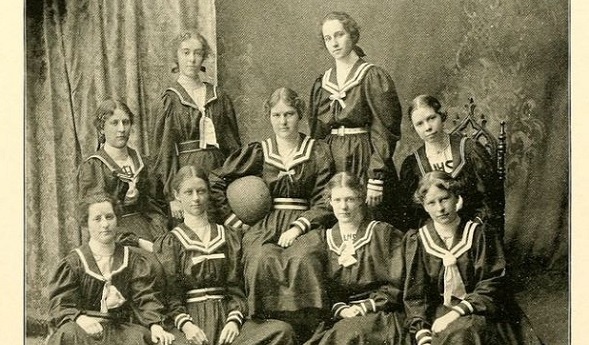
Girls Basketball Builds Century-Long Legacy
By
Ron Pesch
MHSAA historian
February 1, 2016
A stroll through old high school yearbooks illustrates the amazing history of sports in Michigan.
Here one can see evolution. We see the influence of fashion, technology and the norms of society on uniform design, equipment and the games that we play. We see how photography changed.
Look cautiously, and with additional investigation, we can catch glimpses into the effects of migration patterns in our country. Turning pages, we can sometimes catch the building of gymnasiums, stadiums and fields of play.
With careful study and research, we can also gain knowledge on how education handled the female athlete.
Dr. James Naismith created the game of basketball back in 1891 in Massachusetts at the Springfield YMCA. In Michigan, the sport dates back to at least 1898, when some senior girls at Lansing Central High School raised money for “baskets” and wine color “suits” trimmed in white braid and formed a basketball team.
“Their four games were played against the (Michigan Agricultural College) girls’ team. Two of these games were played before the public in the Lansing Armory,” wrote Lewis L. Forsythe, president of the MHSAA from 1924 to 1942, in his book, Athletics in Michigan High Schools: The First Hundred Years.
Hence, it is believed that the girls game predates the boys version at the high school level in the Great Lakes state. While we don’t know what rules were used by the Lansing Central girls, initially, girls played basketball by the same 13 rules created by Naismith. Senda Berenson, director of physical training at Smith College in Massachusetts, had read about Naismith’s game.
 “As the game was first played it was almost too rough for girls or women to play,” states an article in the December 24, 1899, Springfield, MA Republican newspaper. Based on the suggestions from the players and the stamina of the girls she taught, Berenson altered Naismith’s original 13 rules to make the game more suitable for women. Her rules allowed 5-10 players on the court at a time on a court divided into three sections. By design, the players could not leave their section of the court. Like the men’s game, it was played during the winter sports season.
“As the game was first played it was almost too rough for girls or women to play,” states an article in the December 24, 1899, Springfield, MA Republican newspaper. Based on the suggestions from the players and the stamina of the girls she taught, Berenson altered Naismith’s original 13 rules to make the game more suitable for women. Her rules allowed 5-10 players on the court at a time on a court divided into three sections. By design, the players could not leave their section of the court. Like the men’s game, it was played during the winter sports season.
“So, at the conference of physical training held here last June,” continued the article in the Republican, “a committee of prominent physical directors of women’s colleges was appointed to draw up a set of rules.” The guidelines were adopted and the American Sports Publishing Company published “Basket Ball for Women” as part of their Spalding athletic library. Spalding guides were used by physical directors at colleges and schools across the country. Berenson would serve as editor of the Spalding guide until 1917.
“Basketball as an interscholastic game developed rapidly between 1913 and 1920,” wrote Forsythe in his book. “And quite naturally, as had been the case in other sports, the schools … came to talk about their status as ‘champions,’ or were acclaimed such by admiring followers or the press. Inevitably and perhaps with some ulterior motive, a college or a city came forward and proposed to conduct a ‘tournament’ to decide the issue among several schools.”
State Championships
Boys basketball tournaments in Michigan, designed to identify a state champion, date back to 1917 and perhaps before. Yet the governing bodies for high school sports did not sponsor a girls basketball championship tournament until 1973.
Why the difference?
As noted, it’s not that girls didn’t play basketball. The sport remained quite popular into the late 1920s. Like the boys prior to the arrival of the tournaments, local newspapers were quick to proclaim “state championship” honors for successful squads.
The 1914 Grand Haven girls team listed nine players on the team, with six positions listed: Running Center; Jumping Center; Left Guard; Right Guard; Left Forward; Right Forward. The team traveled by train to away games that winter and posted a 5-1 record against regional opponents. (The Grand Haven boys played eight games that year). The Grand Haven Daily Tribune proclaimed the girls “one of the best teams in Western Michigan if not the entire state.”
“Though hindered by lack of proper gymnasium room, 40 Central high school girls are practicing faithfully for basketball, now that a first class schedule has been arranged,” came word in a late December 1921 issue of the Flint Journal. The girls team from East Lansing High School occupied one of the spots on the published Flint Central schedule.
East Lansing’s girls were considered defending state champions after posting consecutive undefeated seasons in the winters of 1919 and 1920. The 1921 team continued the tradition, posting nine straight victories before falling 38-26 to Birmingham, another state power. East Lansing finished the regular season with a 13-1 record (although, it appears the contest with Flint never occurred).
 In April 1921, for the first time, four of the state’s strongest girls squads were invited to Michigan Agricultural College for a tournament. Although unsanctioned by the state’s high school athletic governing body, the old Michigan Interscholastic Athletic Association, the press felt that this invitational would decide a girls state champion. The games were played at the same time as the boys Class A tournament games at M.A.C. On Friday, Birmingham’s girls downed Saginaw, while East Lansing defeated Onaway. In the tournament final Saturday night, East Lansing avenged a regular season loss to Birmingham by a score of 50-15.
In April 1921, for the first time, four of the state’s strongest girls squads were invited to Michigan Agricultural College for a tournament. Although unsanctioned by the state’s high school athletic governing body, the old Michigan Interscholastic Athletic Association, the press felt that this invitational would decide a girls state champion. The games were played at the same time as the boys Class A tournament games at M.A.C. On Friday, Birmingham’s girls downed Saginaw, while East Lansing defeated Onaway. In the tournament final Saturday night, East Lansing avenged a regular season loss to Birmingham by a score of 50-15.
“There was little doubt in the minds of those that saw the return game but what East Lansing could rightfully claim the State’s championship for this, the third consecutive year,” wrote Raynor Hall, the athletic editor of the Ceniad, in the East Lansing annual.
Plans were in place to host another invitational in 1922, but were abandoned by the Agricultural College when more than 30 teams requested entry into the tournament. Without preliminary games for elimination, it became impossible to select representative teams. That, however, did not prevent squads from laying claim to state honors.
With the defeat of Onaway in its season finale before a crowd of 400, the Tawas City girls team proclaimed itself 1922 champion of northeastern Michigan and beyond. While newspapers around the state debated assertions on the crown by Tawas City, Muskegon and Saginaw Eastern, all once beaten during the season, the Three Rivers girls tossed their achievements into the ring. It was tough to question their merit. According to the Kalamazoo Gazette, the girls scored 518 points to their opponents’ 126 over 11 straight wins, including a 40-4 victory over Decatur, a team previously unbeaten in 13 games.
Following a victory over East Lansing on their home floor in March of 1923, the Birmingham Eccentric wrote, “This was the last game of the season for the Birmingham girls. They have won all their high school games and lost two independent games to the Central Methodist team. They may, for the third consecutive year, claim the championship of Michigan.”
Changes afoot
Activities at the 1923 convention of the American Physical Education Association would soon impact athletics for females in Michigan and across the United States. With the publication of the Official Handbook of the National Committee on Women’s Athletics, approaches began to shift as society wrestled with who should control athletic instruction for women. Despite the popularity, many academics, superintendents and school administrators felt that interscholastic competition was inappropriate for females, and suggested that it should differ from that of men. An emphasis on “play for play’s sake” and “a sport for every girl and every girl in a sport” gripped athletic instruction and administration.
Still, in Traverse City, a total of 50 girls tried out for the high school basketball team in 1925, “making it possible to select a team of unusual skill,” according to the editors of the school’s yearbook, The Pines. That same season, Coach Tena Nelson’s Muskegon Heights squad tallied 14 straight victories, and laid claim to the state’s mythical crown following a season-ending victory over that Traverse City team.
One year later, the 1926 Aurora annual from Saginaw High School (also known as Saginaw Eastern) described that philosophical shift that had swept across the state.
“This year girls’ athletic contests have been conducted under a plan very different from that of former years. Under the old system of inter-scholastic athletics very few girls could participate in the various sports. Now, under the new plan of intramural athletics, it is possible to include a large number of girls because each class has several teams. Thus the various classes compete with each other. Although the varsity girls have had to give up out of town games they have retained their enthusiasm for athletics.”
The 1926 Saginaw Arthur Hill yearbook, Legenda, summed it up more bluntly: “Due to an agreement made by the girls’ physical directors of Saginaw Valley to discontinue interscholastic games, only interclass games and those with Saginaw Eastern were played.”
Under the banners like Girls Athletic Association or Girls Athletic Club, intermural programs were established by administrators at numerous high schools across the state. In many cases, a point system was set up, based on participation, designed to determine the awarding of varsity letters. As more schools moved to this model, which often featured competition between sophomore, junior and senior classes, there were fewer schools to compete against interscholastically.
The 1928 edition of Grand Haven High School’s annual, Blue & Gold, noted that the girls basketball team won only two of seven games that school year. The 1929 edition of the yearbook stated, “No regular High School girls’ team was organized this year, but rather than giving a few the privilege of playing, Miss Smith organized a (intramural) league giving all girls a chance to play.”
At Muskegon Heights, the 1928 team finished with a 4-2 record. In 1929, the school had switched to inter-class basketball, with the school title won by the junior class.
Intra-Mural competition over Interscholastic
While by no means was the approach universal, for the next 30 years plus, girls across Michigan saw options to compete against other schools decrease.
With the 1929 arrival of Vaughn Blanchard, who served as director of health and physical education in Detroit, city league schools withdrew from statewide competition following the 1929-30 school year. As the state’s largest city, Detroit schools offered a broad range of competitive athletics, including competition in sports not offered by many outstate schools. Blanchard believed there was an overemphasis on competitive athletics, and chose to focus on a program of greater intra-school intramural activity.
Strong “house” programs of intramural athletics were added in Detroit and girls varsity basketball was retained. However, unlike past seasons, no city championships were played beginning with the 1930-31 season.
“Will intramural sports eventually replace interscholastic contests?” was the question raised in the 1933 Detroit Southeastern annual under the banner Girls’ Sports. “This is the question which will be answered in the very near future; in fact, there have been several decisive steps taken in this direction.”
Girls basketball competition among Detroit Public School League teams did continue in Detroit. Hamtramck completed a seven game schedule undefeated in 1935 against teams from Detroit Central, Northeastern, Western, Southeastern, Eastern, Northern, and Cass Tech.
 Outside Detroit, competition did remain between some smaller rural schools across pockets of Michigan, where intramural might not be practical due to small class sizes. For example between 1937 and 1942, White Cloud’s girls played a changing array of teams from Hesperia, Newaygo, Grant, Ravenna and Baldwin.
Outside Detroit, competition did remain between some smaller rural schools across pockets of Michigan, where intramural might not be practical due to small class sizes. For example between 1937 and 1942, White Cloud’s girls played a changing array of teams from Hesperia, Newaygo, Grant, Ravenna and Baldwin.
In 1938, girls basketball rules were officially changed to state that teams were made up of six players per side and the court was divided into two with three players on the offensive and three players on the defensive end.
“In the years following World War II, attitudes concerning women in general, and their participation in sports, had begun to change”, stated Joan S. Hult in the book, A Century of Women’s Basketball. Those changing attitudes, combined with the prosperity of the war years, did see girls interscholastic basketball return to some Michigan schools in fits and starts.
In Fremont, “the Packerettes, with Mrs. Miller as coach, entered their second year of existence with several losses to their credit,” noted a writer in the school’s 1946 annual, Mogul. “Only two of the players were back from last year’s team.”
Detroit Southeastern ended the 1945 season with two victories and two losses. The 1948 Detroit Cass Tech girls played games against teams from other Detroit school: Mackenzie, Eastern, Southeastern, Southwestern and Detroit Commerce.
 However, in the 1949 yearbook, it appears Fremont’s girls basketball team had changed to a girls sports club teaching the fundamentals of basketball. Based on 1955 annuals from Hesperia, Ravenna and Newaygo, it appears girls basketball disappeared from the varsity sports menu at those schools as well.
However, in the 1949 yearbook, it appears Fremont’s girls basketball team had changed to a girls sports club teaching the fundamentals of basketball. Based on 1955 annuals from Hesperia, Ravenna and Newaygo, it appears girls basketball disappeared from the varsity sports menu at those schools as well.
While the boys continued to explore an expanded menu of sports activities (including football, basketball, swimming, baseball, track, wrestling, tennis and golf), many yearbooks featured girls only as cheerleaders (which prior to the war had also been dominated by men). Competitive athletics didn’t always fit well with the "sugar and spice and everything nice" viewpoints of the time.
Still, the game found a home in some places. In the 1954 New Lothrop annual, the senior class celebrates its class history.
“The fall of 1953 finally arrived. … In this year our school got its gym, and we started our first year of Girls Basketball, by winning the first game from Byron.”
Girls basketball teams can also be found in cities like Morrice, Corunna, Fowler, and Holt, as well as in Detroit-area parochial schools like Detroit Servite and Harper Woods Regina and the Detroit PSL.
Changing Times
In 1966, the MHSAA formed the Girls Athletics Committee to look at the growth in girls high school sports in Michigan and across America. The group held its first meeting in October of that year with the intent of offering guidelines for schools choosing to offer girls athletic programs. For many, it signified the start on the long road back.
Advancements were slow but steady. For example, prior to the 1968-69 season the MHSAA Representative Council took action to increase the allowable number of varsity high school games from eight to 10 per team. In April of 1969, a move was made to sponsor a two-year experimentation using five-player basketball contests (involving extensive changes to the rules outlined in the official guide for the Michigan Division of Girls and Womens Sports). In 1971, the number of basketball games allowed for junior high school teams was increased from five to eight. Finally, the official rules of the game were changed to five-player, full-court basketball.
Still schools were not required to offer interscholastic athletics programs for females in 1971. A survey by the National Federation of High School Athletic Associations showed 707 high schools in Michigan offered boys basketball, while 296 sponsored girls basketball. Post-high school opportunities within the sport were slim. In addition, there were relatively few four-year colleges offering scholarships for women basketball players.
The arrival of Title IX on June 23, 1972 changed that. Legislation prohibiting discrimination against students based on race, sex, or religion, Title IX forced the creation of women’s athletic programs at high schools and colleges across the nation. With that, according to a survey by the National Federation, 699 high schools in Michigan sponsored boys basketball, while 627 offered girls basketball.
Oklahoma began tournament play for girls in 1919, missing one state championship in 1934 because of the depression. In Iowa (where the girls often outdrew the boys during March Madness), the women's tourney began in 1920. In December 1973, eight high school teams gathered at each of four sites around Michigan to compete for the first MHSAA Girls Basketball titles. In addition, many schools now offered softball, tennis, swimming, volleyball and track & field programs. With the stroke of a president’s pen, the world of high school athletics, and the view of the female, changed.
 Ron Pesch has taken an active role in researching the history of MHSAA events since 1985 and began writing for MHSAA Finals programs in 1986, adding additional features and "flashbacks" in 1992. He inherited the title of MHSAA historian from the late Dick Kishpaugh following the 1993-94 school year, and resides in Muskegon. Contact him at [email protected] with ideas for historical articles.
Ron Pesch has taken an active role in researching the history of MHSAA events since 1985 and began writing for MHSAA Finals programs in 1986, adding additional features and "flashbacks" in 1992. He inherited the title of MHSAA historian from the late Dick Kishpaugh following the 1993-94 school year, and resides in Muskegon. Contact him at [email protected] with ideas for historical articles.
PHOTOS: (Top) The Lansing Central girls basketball team, in 1898, is believed to be the first girls high school team in Michigan. (Middle top) This Spalding guide outlined the rules for girls basketball. (Middle) The 1921 East Lansing girls team was a force of its time. (Middle below) The 1946 Fremont team played the second season of girls basketball at that school. (Below) The 1957 Detroit Northern team was among those representing Detroit Public School League member schools. (Photos collected by Ron Pesch.)
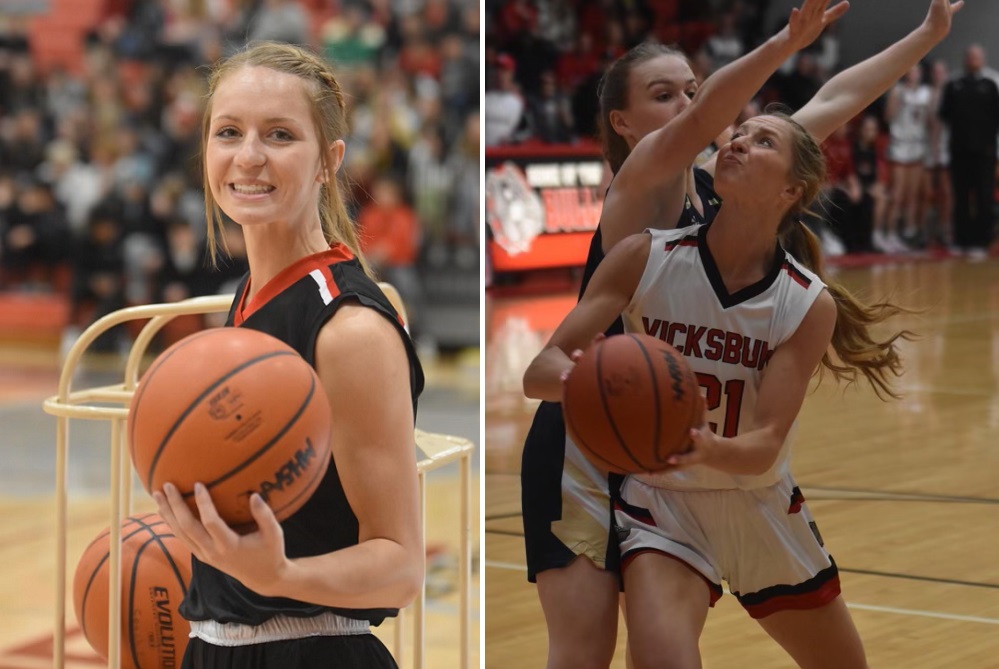
Fearful Start Behind Her, Abnet Continuing to Amaze for Undefeated Vicksburg
By
Pam Shebest
Special for MHSAA.com
February 7, 2023
VICKSBURG – It is not often that a mother calls her child’s concussion a blessing, but it certainly was for Vicksburg senior Tristin Abnet.
 The concussion, sustained her freshman year during a volleyball game, led to tests which led to the discovery of a brain tumor.
The concussion, sustained her freshman year during a volleyball game, led to tests which led to the discovery of a brain tumor.
Luckily, the tumor was benign and, after the surgery and a long recovery, Abnet is one of two seniors on the undefeated girls basketball team that has set a program record this winter for most wins in a season at 16 and counting, eclipsing the previous mark of 15.
And when it comes to Abnet’s journey over the last three years, Bulldogs coach Tim Kirby said it’s been nothing short of amazing.
After taking a hit during a volleyball game, “I actually got a concussion and I ended up with a headache for about a month or so,” Abnet said.
“I didn’t think too much of it because I always got injuries and always got over them. But this one scared me a little bit.”
It was not until she was playing in a college exposure softball tournament that November that she realized something more was going on.
“Tristin was an up-and-coming softball athlete throughout the country,” her dad, Cheyenne, said. “She won many national championships up to her freshman year (in travel softball).
“We were playing at a college exposure tournament, and she was the youngest on the team. The third day (of the tournament) she started crying because her headache was so bad. She asked me if I would take her out.”
Her mother, Kristina, added, “That was so unlike T. She would battle through anything.”
At that moment, they knew something was terribly wrong.
“She was only making it through maybe two days of school every week because of headaches,” Kristina said. “We took her to her family doctor (in November), and they weren’t comfortable with everything.
“Her doctor (Rosa Maira) said she felt it necessary to do further imaging. Had she not, we’d still never know.”
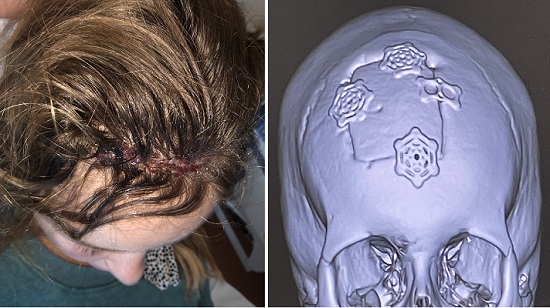 The wait during the imaging dragged on, causing a bit of concern for her parents.
The wait during the imaging dragged on, causing a bit of concern for her parents.
“They kept her for so long, and I said there’s something wrong – Mother’s intuition,” Kristina said.
“Then they came out and took us back and showed us what they found and asked to do further testing. Everything snowballed after that.”
Finding out about the tumor, “My world crashed,” Kristina said, with tears in her eyes. “(In 2011) I had a lot of tumors, desmoid tumors, and to think of the battle I went through and the fact that it was on her brain, it was tough.”
In March, doctors performed a biopsy, finding Tristin’s tumor was a low-grade glioma, which is benign.
“We all lost it that day,” Kristina said. “We had our entire family there for her first surgery in March. We left (the hospital) three days later, and then COVID hit.”
With classes online, “She ended up not having to go back to school that year, so that was a blessing too.”
The surgery to remove the tumor was scheduled for August 2020, and during the months between the biopsy and surgery, Tristin said, “I didn’t want to freak myself out because I knew it was coming, I knew what was going to happen and there was nothing I could do about it.”
Her dad said Tristin “never cried in front of me from the day at the tournament all the way to the day of her surgery.
“She was so, so strong, and she was just a little girl. I never saw a tear until they were ready to wheel her away for the surgery.”
One worry for Tristin was the chance of losing her hair to facilitate the craniotomy.
“First they told me they were going to shave my head halfway back and then, as I was getting wheeled back, there were two girl nurses talking about what they were going to do with my hair, so I knew they weren’t going to completely shave my head,” Abnet said.
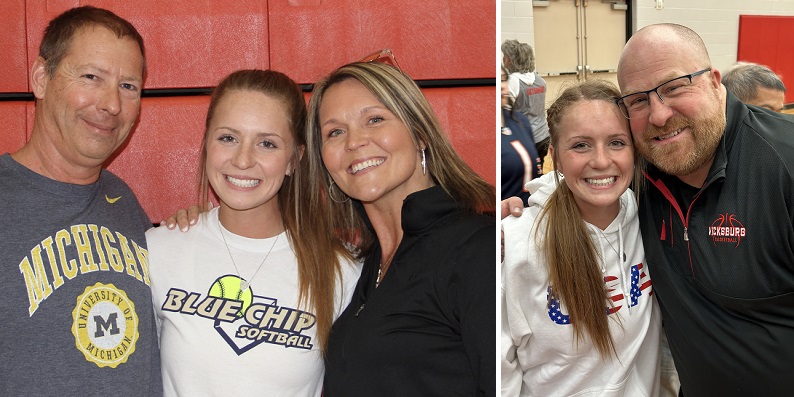 The surgery lasted 13 hours at Helen DeVos Children’s Hospital in Grand Rapids, and three days later she was headed home to her bedroom decorated by friends and family.
The surgery lasted 13 hours at Helen DeVos Children’s Hospital in Grand Rapids, and three days later she was headed home to her bedroom decorated by friends and family.
At first, Tristin was allowed no competition for six months after the surgery. But after a CT scan, doctors added another two months before giving her the OK to play.
“There are (three) metal plates there, that’s why she could not go back to sports for such a long time because that plate had to heal,” her dad said.
Although she could not play basketball her sophomore year, she found a way to stay involved: She became the varsity team manager.
“As a sophomore she literally was here for every practice and every game, even though she wasn’t allowed to participate,” Kirby said.
“At the end of the season, her team unanimously voted her “best teammate” on the entire team, and she couldn’t play. I think that’s a testament to the kind of person she is and the impact she had on the team.”
After taking a year off and after major surgery, Abnet had a lot of catching up to do, both physically and mentally, during her junior year, her coach said.
“Last year, you just wanted to make sure you kept her safe,” Kirby noted. “This year, I haven’t worried about it as much because she’s been through it and we’re all more comfortable with it.
“She knows what her limitations are. Last year, I was a little more leery about it.”
Tristin worked her way back into shape.
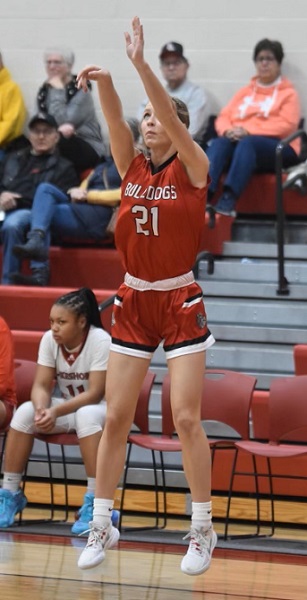 “She goes to the gym four days a week,” her mom said. “She’s literally built up about 10 pounds of muscle.
“She goes to the gym four days a week,” her mom said. “She’s literally built up about 10 pounds of muscle.
“She lost 35 pounds after her brain surgery. She went from being a fit athlete to being very tiny, very fragile.”
Those first few games back last year were also nail-biters.
“I was absolutely terrified,” her mom said. “One hit to her head and her forehead could concave.”
They were a bit daunting for Tristin as well.
“I was super, super nervous because I didn’t want to get hit in the head and have to go through that surgery again,” she said.
Her dad added that the surgery changed her.
“She’s not the athlete she was four years ago; she’s not, and that’s fine,” Cheyenne said. “It took me a while as Dad, as (softball) coach, to understand that. I’m proud of her.”
Through it all, she never let her grades suffer and carries a 4.13 GPA.
She is also called the team “mom,” taking snacks to road games and putting out reminders every day in the team’s group chat.
“She inspires me every single day,” Kirby said. “When you’re a young team, you have to have that leadership. She’s a great leader for us. She bonds everybody together.”
That bonding is one thing that is so special about the Bulldogs, Kirby said.
“They work hard every day and they share the basketball like nobody I’ve ever seen before,” he explained. “Every night, someone else leads us in scoring.
“I’ve had seven different girls lead us in scoring this year, and I don’t have anyone averaging 10 points a game right now.”
Amanda Laugher joins Abnet as the team’s seniors. The young roster also includes juniors Brooklynn Ringler, Emma Steele and Maddison Diekman and sophomores Scarlett Hosner, Kendra Cooley, Emily Zemitans, Makayla Allen and Hannah Devries.
As for the school record, that was not the team’s goal at the beginning of the season.
“Our goal this year is to win the (Wolverine) Conference championship,” Kirby said. “Vicksburg has never won a conference championship in girls basketball. That was our No. 1 goal this year.
“We host our District this year, so we’re hoping maybe to follow up a conference championship with a District championship. You get to that point, and it’s all gravy.”
 Pam Shebest served as a sportswriter at the Kalamazoo Gazette from 1985-2009 after 11 years part-time with the Gazette while teaching French and English at White Pigeon High School. She can be reached at [email protected] with story ideas for Calhoun, Kalamazoo and Van Buren counties.
Pam Shebest served as a sportswriter at the Kalamazoo Gazette from 1985-2009 after 11 years part-time with the Gazette while teaching French and English at White Pigeon High School. She can be reached at [email protected] with story ideas for Calhoun, Kalamazoo and Van Buren counties.
PHOTOS (Top) Vicksburg’s Tristin Abnet is glad to be back on the court, and intense going to the basket. (2) Stitches stretched across Abnet’s scalp as three metal plates and a hinge were applied to her skull. (3) Abnet is surrounded by support including parents Cheyenne, left, and Kristina, and coach Tim Kirby. (4) Abnet launches a jumper during a game with Stevensville Lakeshore. (Photos courtesy of the Abnet family.)

